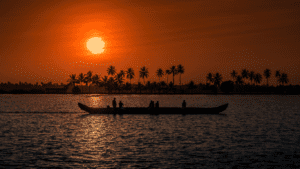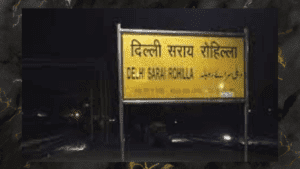Nestled in the heart of Himachal Pradesh’s Kinnaur district, Yulla Kanda is a hidden gem that combines breathtaking nature with deep spiritual meaning. This 11-12 km trek takes you to a serene lake and the world’s highest Krishna temple, sitting at 3,895 meters (12,778 feet). Whether you’re a trekker seeking adventure or a pilgrim looking for peace, Yulla Kanda offers a unique journey. This article explores the trek, its cultural and spiritual significance, and practical tips to make your visit unforgettable. Written in a warm, human tone, it’s your guide to discovering this sacred spot in the Himalayas.
The Magic of Yulla Kanda
Yulla Kanda is more than just a trek—it’s a journey through stunning landscapes and rich traditions. Located in the Rora Valley, the trail winds through pine forests, meadows, and snow-capped peaks. At its heart lies a glacial lake with a Krishna temple, believed to be built by the Pandavas during their exile. The temple’s location at 12,778 feet makes it the highest of its kind, drawing trekkers and devotees alike. The area’s peaceful vibe and natural beauty make it a perfect escape from crowded tourist spots.
The Krishna Temple
The Krishna temple at Yulla Kanda is a spiritual highlight. Set in the middle of a glacial lake, it’s said to have been created by the Pandavas, giving it a deep connection to the Mahabharata. Locals believe Lord Krishna visited this spot, adding to its sacredness. The temple welcomes everyone, regardless of faith, and its unique setting at such a high altitude makes it a must-visit for those seeking spiritual calm amidst nature’s beauty.
The Sacred Lake
The Yulla Kanda lake is as special as the temple. At 3,895 meters, its clear waters reflect the surrounding peaks. Locals say dipping your hands in the lake can clear negativity, offering a sense of peace. A unique tradition involves floating a Kinnauri cap across the lake—if it reaches the other side, it’s a sign of good fortune for the year ahead. This ritual, tied to the Janmashtami festival, adds a magical touch to the trek.
The Yulla Kanda Trek
The trek to Yulla Kanda is a moderate 11-12 km journey, perfect for beginners and seasoned trekkers. Starting from Yulla Khas village, the trail takes you through lush meadows, dense forests, and rocky paths. The 3-4 day adventure offers stunning views of the Kinnaur mountains and a chance to camp under starry skies. Best done from May to October, the trek blends adventure with the calm of the Himalayas, making every step worth the effort.
Starting at Yulla Khas
Your journey begins in Yulla Khas, a small village in Kinnaur known for its warm locals and apple orchards. From here, you trek 3 km to a meadow that serves as the base camp. The village is reachable by a 7-hour drive from Shimla to Tapri, followed by a short ride to Yulla Khas. The welcoming vibe of the village, with its simple homestays and local food, sets a cozy tone for the trek ahead.
The Trekking Route
The main trek from the meadow to Yulla Kanda lake is 8-9 km, taking about 4-6 hours. You’ll pass through pine forests, open meadows, and streams, with snow-capped peaks in view on clear days. The trail is moderately challenging, with some steep sections, but the beauty of wildflowers and Kinnauri architecture keeps you motivated. By late afternoon, you reach the lake and temple, where you can set up camp and enjoy the serene surroundings.
Camping by the Lake
Camping at Yulla Kanda is a highlight. After reaching the lake, you can pitch tents at the base camp near the water. The night sky, filled with stars, and a warm bonfire create a magical vibe. Campsites like Camp 2 offer cozy tents and blankets, even in the off-season. Sharing stories with fellow trekkers and soaking in the quiet of the Himalayas make this an experience to cherish.
Spiritual and Cultural Significance
Yulla Kanda is steeped in spiritual and cultural importance. The Krishna temple and lake are tied to the Pandavas, making it a sacred site for Hindus. The Janmashtami festival brings locals and pilgrims together to celebrate with joy and devotion. The Kinnaur region’s traditions, like the cap-floating ritual, add a unique charm. The trek also offers a glimpse into the local way of life, with friendly villagers and their deep connection to nature.
The Janmashtami Festival
Every year during Janmashtami, Yulla Kanda comes alive with celebrations. Locals and visitors gather to honor Lord Krishna’s birth, singing songs and sharing meals like rajma chawal. The festival, started by King Kehari Singh of Bushah, reflects the region’s rich heritage. The cap-floating ritual, where a Kinnauri cap is placed in the lake to predict the year’s fortune, is a highlight that draws crowds for its spiritual charm.
Kinnaur’s Local Culture
Kinnaur’s culture shines through on the Yulla Kanda trek. The people of Yulla Khas are known for their warmth, often offering apples or tea to visitors. Traditional Kinnauri architecture, with wooden homes and sloped roofs, dots the trail. The region’s respect for nature is evident in clean-up drives by groups like the Himalayn Tribe Foundation, ensuring the area stays pristine for future visitors.
Preparing for the Trek
Getting ready for Yulla Kanda is key to a safe and fun trip. The trek is best done between mid-May and mid-October when the weather is clear and trails are snow-free. You’ll need good trekking shoes, warm layers, and a backpack with essentials like a water bottle and snacks. Light cardio and leg workouts 2-3 weeks before can help build stamina. Always check with locals or guides for weather updates before starting.
Best Time to Visit
The ideal time for the Yulla Kanda trek is May to October. May and June offer crisp air and melting snow, while July and August bring green meadows and wildflowers. September and October have golden landscapes and clear skies. Monsoon months (July-August) can make paths slippery, so be cautious. Winter brings snow, making the trek tougher but visually stunning for experienced trekkers.
What to Pack
Pack smart for Yulla Kanda. Bring sturdy trekking shoes, a waterproof jacket, warm layers, gloves, and a beanie for chilly nights. A headlamp, reusable water bottle, and power bank are handy. Carry basic medicines, ORS, and energy bars for emergencies. A light backpack (avoid heavy loads) and a good sleeping bag for camping will keep you comfortable. Check with your trek organizer for included gear.
Practical Tips for Trekkers
The Yulla Kanda trek is rewarding but needs some planning. Book with a trusted organizer for guides, permits, and meals. Stay hydrated and pace yourself to handle the altitude. Respect the local culture by keeping the area clean and following village customs. A friendly trip captain or local guide can make the journey smoother, offering tips and stories to enrich your experience.
Finding Accommodation
In Yulla Khas, a family-run homestay offers clean, affordable rooms near the bus stop. On the trek, Camp 2 at the lake provides tents with warm blankets, open even in the off-season. Tapri, a stop before Yulla Khas, has basic hotels for a restful night before starting. Book early during peak seasons (May-June, September-October) to secure spots, as options are limited in this remote area.
Staying Safe
Safety comes first on the Yulla Kanda trek. The altitude (3,895 meters) can cause mild sickness, so rest and hydrate often. Stick to the marked trail and follow your guide’s advice. Carry a first-aid kit and inform someone of your plans. Watch for slippery paths during monsoons. If camping, ensure your tent is secure against strong winds. Always travel with a group or guide for support.
Why Yulla Kanda Stands Out
Yulla Kanda is special because it’s not your typical tourist spot. Unlike crowded Himalayan trails, this trek offers peace and a chance to connect with nature and spirituality. The mix of adventure, culture, and the world’s highest Krishna temple makes it unique. Whether you’re chanting “Hare Krishna” by the lake or stargazing at camp, Yulla Kanda leaves you with memories of beauty and calm.
A Journey of Peace
The trek to Yulla Kanda is as much about inner peace as it is about adventure. The quiet trails, sacred lake, and temple’s serene energy help you unwind. Trekkers often describe feeling refreshed after dipping their hands in the lake or praying at the temple. The lack of crowds lets you soak in the Himalayas’ calm, making it a perfect reset from daily life.
An Offbeat Adventure
Unlike popular treks, Yulla Kanda remains untouched by mass tourism. Its remote location in Kinnaur keeps it quiet, offering a raw Himalayan experience. The trail’s mix of forests, meadows, and cultural encounters feels personal. For those craving something different, this trek delivers adventure, spirituality, and a chance to explore a lesser-known corner of Himachal Pradesh’s stunning landscape.
Conclusion
Yulla Kanda is a trek that blends adventure, spirituality, and nature in a way few places can. From the world’s highest Krishna temple to the serene lake and warm Kinnauri hospitality, it’s a journey that stays with you. Whether you’re trekking for the views, the culture, or a moment of peace, Yulla Kanda delivers. Plan your trip, pack wisely, and get ready for an unforgettable experience in the heart of the Himalayas.




